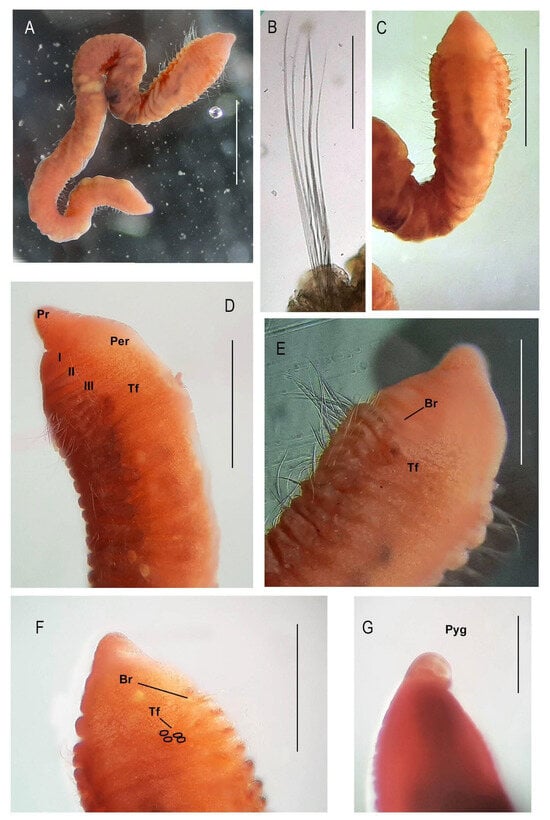Journal Description
Taxonomy
Taxonomy
is an international, peer-reviewed, open access journal published quarterly online by MDPI. It covers the conception, naming, and classification of groups of organisms, including but not limited to animals, plants, viruses, and microorganisms.
- Open Access— free for readers, with article processing charges (APC) paid by authors or their institutions.
- High Visibility: indexed within ESCI (Web of Science), Scopus, AGRIS, and other databases.
- Rapid Publication: manuscripts are peer-reviewed and a first decision is provided to authors approximately 45.2 days after submission; acceptance to publication is undertaken in 4.9 days (median values for papers published in this journal in the second half of 2023).
- Recognition of Reviewers: APC discount vouchers, optional signed peer review, and reviewer names published annually in the journal.
Latest Articles
Protocirrineris stormae: A New Species of Polychaete from The Netherlands (Annelida: Polychaeta: Cirratulidae)
Taxonomy 2024, 4(2), 303-313; https://doi.org/10.3390/taxonomy4020014 - 19 Apr 2024
Abstract
►
Show Figures
Specimens belonging to a new species in the genus Protocirrineris have been found during surveys along the southwestern coasts of the Netherlands. Protocirrineris stormae sp. nov, as described herein, were collected from the muddy bottom sediments in enclosed marine waterbodies and estuaries. This
[...] Read more.
Specimens belonging to a new species in the genus Protocirrineris have been found during surveys along the southwestern coasts of the Netherlands. Protocirrineris stormae sp. nov, as described herein, were collected from the muddy bottom sediments in enclosed marine waterbodies and estuaries. This species is characterized by branchiae commencing from the first chaetiger and tentacular filaments arranged in two groups arising from chaetigers 2–3 that present one/two pairs of lobes, each bearing a single dorsal tentacle. From the current records of this species, it seems that P. stormae has an affinity for enclosed marine environments or parts of estuaries with minimal variability in salinity, higher transparency, and normal temperature regime. The discovery and study of this species contributes to a comprehensive characterization of benthic fauna in locations subjected to particular environmental stresses. Considering the extensive dataset available from the Southwestern Netherlands due to many years of sampling, it is plausible that P. stormae is a pseudo-indigenous species as there seem to be no records of similar or unknown Protocirrineris before 2013.
Full article
Open AccessArticle
Nine New Species of Ilyarachninae Hansen, 1916 (Crustacea: Isopoda: Munnopsidae) from Australia and New Zealand with an Updated Key of the Subfamily from the Southwest Pacific
by
Kelly L. Merrin
Taxonomy 2024, 4(2), 250-302; https://doi.org/10.3390/taxonomy4020013 - 06 Apr 2024
Abstract
►▼
Show Figures
The Ilyarachninae are a diverse and widely distributed subfamily of the asellote family Munnopsidae. This paper describes nine new deep-sea species from two Ilyarachninae genera, Ilyarachna and Notoapais, from the southwestern Pacific, namely from New Zealand and the east coast of Australia.
[...] Read more.
The Ilyarachninae are a diverse and widely distributed subfamily of the asellote family Munnopsidae. This paper describes nine new deep-sea species from two Ilyarachninae genera, Ilyarachna and Notoapais, from the southwestern Pacific, namely from New Zealand and the east coast of Australia. Ilyarachna aculeatus n. sp., Ilyarachna brucei n. sp., Ilyarachna franki n. sp., Ilyarachna mclayi n. sp., Ilyarachna pacifica n. sp., Ilyarachna sami n. sp., Ilyarachna taranui n. sp. and Notopais chathamensis n. sp. are described from New Zealand waters, while Notopais likros n. sp. is described from off the east coast of Australia. Additionally, a redescription of Notopais spinosa from the Balleny Islands, Antarctica, and a revised key to the Ilyarachna and Notopais species from the southwest Pacific are included, and the distribution, affinities, and diagnostic characters of the new species are discussed.
Full article

Figure 1
Open AccessArticle
A New Diving Pliocene Ardenna Shearwater (Aves: Procellariidae) from New Zealand
by
Alan J. D. Tennyson, Rodrigo B. Salvador, Barbara M. Tomotani and Felix G. Marx
Taxonomy 2024, 4(2), 237-249; https://doi.org/10.3390/taxonomy4020012 - 06 Apr 2024
Abstract
►▼
Show Figures
We report a new species of shearwater, Ardenna buchananbrowni sp. nov., from the Pliocene of New Zealand. It is both the smallest and oldest known diving member of the genus, demonstrating that this now abundant form of shearwater has had a long presence
[...] Read more.
We report a new species of shearwater, Ardenna buchananbrowni sp. nov., from the Pliocene of New Zealand. It is both the smallest and oldest known diving member of the genus, demonstrating that this now abundant form of shearwater has had a long presence in southern oceans. Ardenna buchananbrowni sp. nov. is among the few extinct shearwaters described from the Southern Hemisphere and adds to an increasingly diverse seabird assemblage in the Pliocene of the region.
Full article
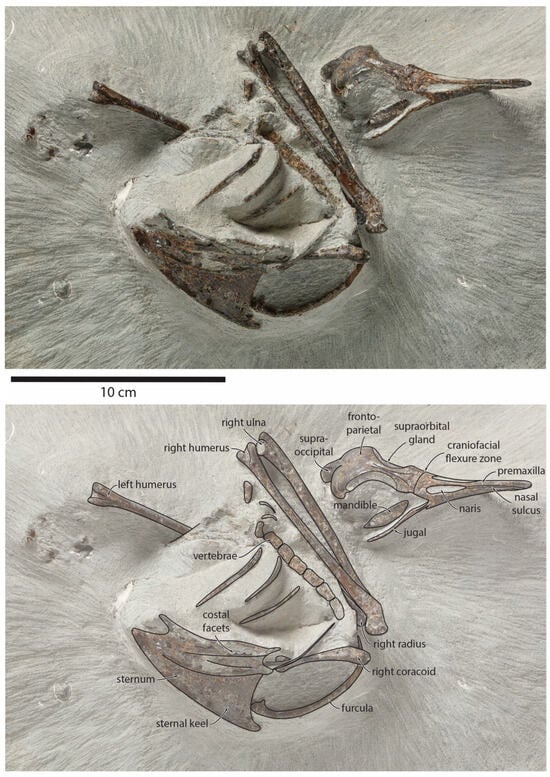
Figure 1
Open AccessArticle
Synopsis of Neotropical Trogolaphysa Mills, 1938 (Collembola: Paronellidae) with Reduced Eye Number, and Description of Two New Troglobiontic Species from Belize
by
Felipe Soto-Adames, Kathryn M. Daly and J. Judson Wynne
Taxonomy 2024, 4(1), 199-236; https://doi.org/10.3390/taxonomy4010011 - 05 Mar 2024
Abstract
►▼
Show Figures
The genus Trogolaphysa comprises 81 described species distributed across the Neotropical and Afrotropical regions. In the Americas, just over half of the species found in subterranean habitats have a reduced eye number (0–5 eyes). Subterranean species are of interest as models to study
[...] Read more.
The genus Trogolaphysa comprises 81 described species distributed across the Neotropical and Afrotropical regions. In the Americas, just over half of the species found in subterranean habitats have a reduced eye number (0–5 eyes). Subterranean species are of interest as models to study the evolution of morphological adaptations. Many subterranean species of Trogolaphysa were described before the introduction of chaetotaxy as a diagnostic tool and thus remain incompletely described and diagnosed. To identify gaps in descriptions and facilitate the identification of newly collected forms, we provide standardized summary descriptions, species diagnoses, diagnostic tables, and a dichotomous key to the 33 Neotropical species of Trogolaphysa with reduced eye number. As a result of this synthesis, we describe two new troglobiontic species, Trogolaphysa reneaui n. sp. and Trogolaphysa welchi n. sp. from Belizean caves.
Full article
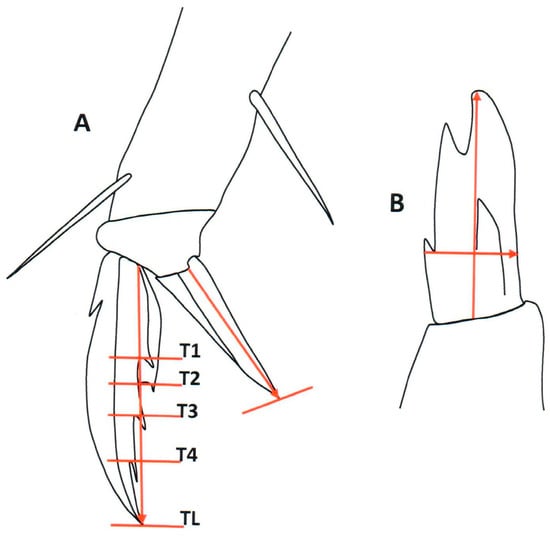
Figure 1
Open AccessArticle
Genomic Insights into the Taxonomy and Metabolism of the Cyanobacterium Pannus brasiliensis CCIBt3594
by
Mauricio Junior Machado, Natalia Betancurt Botero, Ana Paula Dini Andreote, Anderson Miguel Teixeira Feitosa, Rafael Vicentini Popin, Kaarina Sivonen and Marli F. Fiore
Taxonomy 2024, 4(1), 184-198; https://doi.org/10.3390/taxonomy4010010 - 05 Feb 2024
Abstract
►▼
Show Figures
The freshwater Pannus genus comprises cyanobacterial unicellular species with a particular morphology, forming free-floating rounded colonies with thin, homogenous, and colorless colonial mucilage. There is little literature on the taxonomy of the Pannus and none on its metabolism. This study presents the first
[...] Read more.
The freshwater Pannus genus comprises cyanobacterial unicellular species with a particular morphology, forming free-floating rounded colonies with thin, homogenous, and colorless colonial mucilage. There is little literature on the taxonomy of the Pannus and none on its metabolism. This study presents the first genomic characterization of a Pannus strain isolated from Pantanal Biome, Brazil. The genome was assembled into 117 contigs with a total size of 5.1 Mb and 99.12% completeness. It contained 4988 protein-encoding genes, including some involved in secondary metabolite biosynthesis, such as cyanobactin and terpenes. Interestingly, P. brasiliensis CCIBt3594 has a complete set of nitrogen fixation genes and is a non-heterocytou unicellular cyanobacterium. Finally, the phylogenomic analyses revealed the lack of information on closely related strains and anchored the genus Pannus within the order Chroococcales, Microcystaceae family, closest to Microcystis spp. representatives. This work presents novel evidence concerning a sparsely characterized genus of the Cyanobacteria phylum and contributes to elucidating taxonomic and systematic issues within the group of unicellular cyanobacteria.
Full article
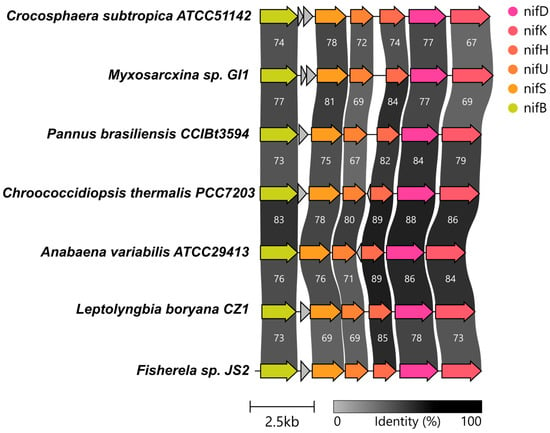
Figure 1
Open AccessArticle
The Swedish Aeolothripidae and Melanthripidae (Thysanoptera) with a Redescription of Rhipidothrips niveipennis Reuter, 1899
by
Emma Wahlberg
Taxonomy 2024, 4(1), 163-183; https://doi.org/10.3390/taxonomy4010009 - 01 Feb 2024
Abstract
►▼
Show Figures
This study explores the Swedish diversity of the thrips families Aeolothripidae and Melanthripidae. Currently, a total of 12 species in 2 genera of Aeolothripidae occur in Sweden, and 1 in Melanthripidae. The aims of this study include to provide an updated identification key
[...] Read more.
This study explores the Swedish diversity of the thrips families Aeolothripidae and Melanthripidae. Currently, a total of 12 species in 2 genera of Aeolothripidae occur in Sweden, and 1 in Melanthripidae. The aims of this study include to provide an updated identification key with photographic material and an updated checklist of the country with provincial records. In this study both museum material and new material collected in understudied provinces are included, and a large number of molecular barcodes are produced. The results reveal 26 new provincial records in Sweden, predominantly in northern regions, and 11 provinces in total had new species records. New records of Rhipidothrips brunneus Williams 1913 warranted an examination of distinguishing characters compared to R. niveipennis Reuter, 1899. The original description of R. niveipennis is found to lack sufficient characters to delimit the species, and a redescription based on syntypes is presented.
Full article

Figure 1
Open AccessArticle
Molecular Discrimination for Two Anadenanthera Species of Seasonally Dry Tropical Forest Remnants in Brazil
by
Fernando Bonifácio-Anacleto, Rômulo Maciel Moraes Filho, Leonardo Maurici Borges, Carlos Alberto Martinez and Ana Lilia Alzate-Marin
Taxonomy 2024, 4(1), 150-162; https://doi.org/10.3390/taxonomy4010008 - 01 Feb 2024
Abstract
►▼
Show Figures
Anadenanthera colubrina (Acol) and Anadenanthera peregrina (Aper) (Fabaceae) are two species popularly known as “angicos” that occur in seasonally dry tropical forest (SDTR) remnants in Brazil. Since many of the morphological characteristics of Anadenanthera species are superimposed and species-specific characteristics are difficult to
[...] Read more.
Anadenanthera colubrina (Acol) and Anadenanthera peregrina (Aper) (Fabaceae) are two species popularly known as “angicos” that occur in seasonally dry tropical forest (SDTR) remnants in Brazil. Since many of the morphological characteristics of Anadenanthera species are superimposed and species-specific characteristics are difficult to observe, their identification is complex. Therefore, in this research, a set of ISSR (Inter-Simple Sequence Repeat Polymorphic DNA) molecular markers was standardized, aiming to characterize A. colubrina and A. peregrina species and study the genetic diversity of three populations of each species located within a fragmented landscape in São Paulo State, southeastern Brazil. Seven ISSR markers (UBC 2, 820, 851, 858, 864, 866, and 886) that show polymorphism for both species were used. The Bayesian cluster, PCoA and dendrogram analysis show that the total sample divides into two groups corresponding to each species. Also, a genetic divergence (Gst = 0.143) and a high number of migrants per generation (Nm = 3.0) were detected between them. The Acol populations showed significantly higher values for mean genetic diversity (h = 0.30) than Aper (h = 0.25) (p < 0.05). The ISSR marker UBC2250bp showed species-specific electrophoretic fingerprints for both species. The molecular tools generated herein support the conservation of Anadenanthera sp. and the restoration of vegetation where the species naturally occurs.
Full article
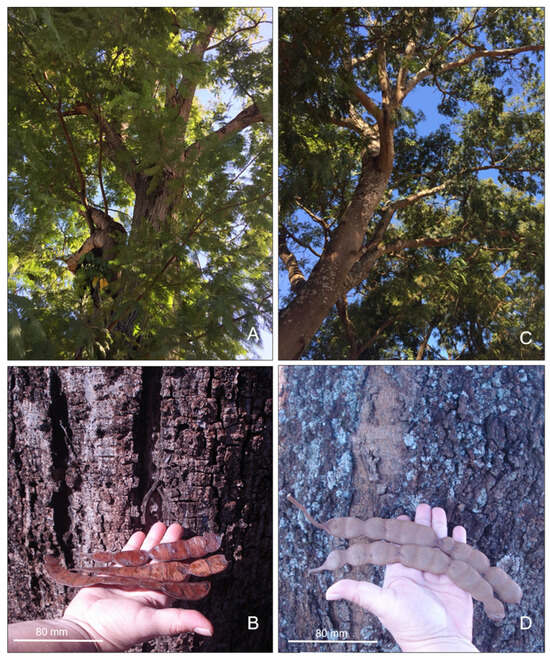
Figure 1
Open AccessArticle
Species of the Western Palaearctic Genus Tetralonia Spinola, 1838 (Hymenoptera, Apidae) with Atypical Pollen Hosts, with a Key to the pollinosa-Group, Description of New Species, and Neotype Designation for Apis malvae Rossi, 1790
by
Achik Dorchin and Denis Michez
Taxonomy 2024, 4(1), 126-149; https://doi.org/10.3390/taxonomy4010007 - 25 Jan 2024
Abstract
►▼
Show Figures
The long-horn bee genus Tetralonia consists of 35 Western Palaearctic species that are associated mostly with the family Asteraceae as host plants. A minority of the species are, however, exclusively associated with other host plants that have particularly large pollen grains, such as
[...] Read more.
The long-horn bee genus Tetralonia consists of 35 Western Palaearctic species that are associated mostly with the family Asteraceae as host plants. A minority of the species are, however, exclusively associated with other host plants that have particularly large pollen grains, such as those in the plant families Caprifoliaceae, Malvaceae, and Onagraceae. This work presents a taxonomic account and morphological description of the assemblages of Tetralonia species with atypical (non-Asteraceae) host plants. It includes a key to the pollinosa-group, which contains most of the species, a description of three regionally restricted new species, namely T. eoacinctella Dorchin sp. nov., T. epilobii Dorchin sp. nov., and T. stellipilis Dorchin sp. nov., a lectotype designation for Eucera cinctella Saunders, 1908 [=Tetralonia cinctella (Saunders, 1908)], and a neotype designation for Apis malvae Rossi, 1790 [=Tetralonia malvae (Rossi, 1790)]. In addition, the name Eucera macroglossa Illiger, 1806 is confirmed as a synonym of Apis malvae Rossi, 1790; Tetralonia macroglossa ssp. xanthopyga Alfken, 1936 is officially placed in synonymy with Apis malvae Rossi, 1790; and Macrocera confusa Pérez, 1902 is listed as a doubtful synonym of Tetralonia scabiosae Mocsàry, 1879 (syn. nov.).
Full article
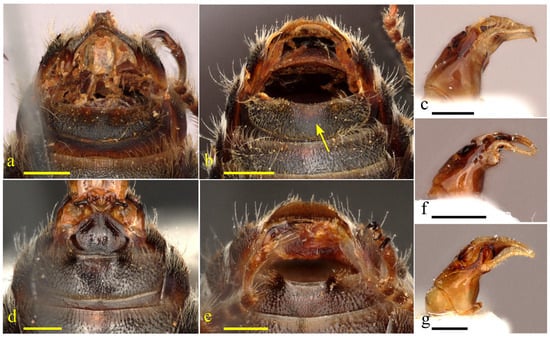
Figure 1
Open AccessArticle
Sideritis royoi (Lamiaceae): A New Orophilous Species from Northeastern Spain
by
Llorenç Sáez, Rafel Curto and Manuel B. Crespo
Taxonomy 2024, 4(1), 112-125; https://doi.org/10.3390/taxonomy4010006 - 18 Jan 2024
Abstract
►▼
Show Figures
Sideritis royoi is found in the rocky limestone habitats of the Port Massif (southern Catalonia, Spain). The species was first collected by the local botanist Lluís de Torres in the late part of the 20th century, but the specimens have remained unidentified positively
[...] Read more.
Sideritis royoi is found in the rocky limestone habitats of the Port Massif (southern Catalonia, Spain). The species was first collected by the local botanist Lluís de Torres in the late part of the 20th century, but the specimens have remained unidentified positively in herbaria for over 40 years. Sideritis royoi likely belongs to section Sideritis subsection Hyssopifoliae and shows some morphological affinities with the relatively widespread South European species S. hyssopifolia L., but it differs from this species because it has subspinescent upper leaves, the main surfaces of its leaves are glabrous or glabrescent, the main abaxial surface of its bracts is without eglandular hairs, and due to the fact that it has shorter inflorescences. Weaker similarities have also been observed with some species belonging to S. subsection Fruticulosae Obón & D.Rivera. In this paper, a description for the new orophilous species is provided, along with a detailed illustration, field photographs, and a comparison with closely related species. We include an assessment of its conservation status and a dichotomous key for the identification of all the species of Sideritis subsection Hyssopifoliae.
Full article
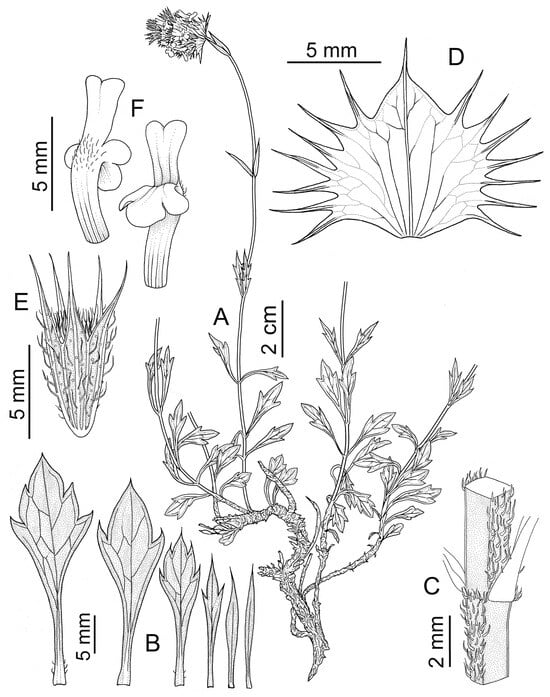
Figure 1
Open AccessArticle
First Record of the Family Hahniidae in Ecuador with Description of Thirteen New Species and Three New Genera (Araneae: Hahniidae)
by
Nadine Dupérré and Elicio Tapia
Taxonomy 2024, 4(1), 53-111; https://doi.org/10.3390/taxonomy4010005 - 12 Jan 2024
Abstract
The Nearctic family Hahniidae is seldom found in South America; only 20 species occur on the continent. Herein, we present the first record of the family in mainland Ecuador, with the description of thirteen new species in five different genera. In Amaloxenops: A. minimalista n.
[...] Read more.
The Nearctic family Hahniidae is seldom found in South America; only 20 species occur on the continent. Herein, we present the first record of the family in mainland Ecuador, with the description of thirteen new species in five different genera. In Amaloxenops: A. minimalista n. sp. (female); in Kasha n. gen.: Kasha patpa n. sp. (male, female); in Neohahnia: Neohahnia catleyi (female) n. sp., N. piemontana n. sp. (male, female), N. pristirana n. sp. (male, female), N. freibergi n. sp. (male, female), N. paramo n. sp. (male, female), and N. chalupas n. sp. (male); in Paramito n. gen.: Paramito papallacta n. sp. and P. oyacachi n. sp.; and in Pristirana n. gen.: Pristirana barthlotti n. sp. (male, female), P. niederi n. sp. (female), and P. nowickii n. sp. (male, female). Distribution maps are presented for all species, as well as a key to the South American Hahniidae genera.
Full article
(This article belongs to the Special Issue Taxonomy, Systematics and Biogeography of Spiders)
►▼
Show Figures
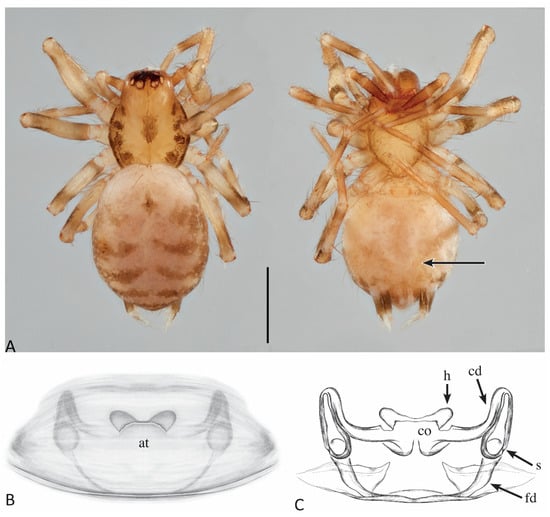
Figure 1
Open AccessEditorial
Looking Back on 2023—A Fruitful Year for Taxonomy
by
Mathias Harzhauser
Taxonomy 2024, 4(1), 51-52; https://doi.org/10.3390/taxonomy4010004 - 08 Jan 2024
Abstract
The turn of the year is a good opportunity to reflect on the past year and summarize the milestones [...]
Full article
Open AccessArticle
Taxonomy, Distribution and Habitat of the Giant Trechus Beetles Endemic to Mt. Choke, Ethiopia (Coleoptera: Carabidae)
by
Joachim Schmidt and Yeshitla Merene
Taxonomy 2024, 4(1), 27-50; https://doi.org/10.3390/taxonomy4010003 - 07 Jan 2024
Abstract
The Holarctic ground beetle genus Trechus Clairville, 1806, is highly diverse in the Ethiopian highlands, both in terms of species numbers and morphology. Particularly noteworthy are the extraordinarily large species of the subgenus Abyssinotus Quéinnec and Ollivier, 2021, with a body length up
[...] Read more.
The Holarctic ground beetle genus Trechus Clairville, 1806, is highly diverse in the Ethiopian highlands, both in terms of species numbers and morphology. Particularly noteworthy are the extraordinarily large species of the subgenus Abyssinotus Quéinnec and Ollivier, 2021, with a body length up to 8.5 mm, that occur on Mt. Choke in northern Ethiopia. Recent, intensive field work on Mt. Choke resulted in a significantly large number of specimens that are the basis for our taxonomic revision of the species related to the giant species, T. dimorphicus Pawłowski, 2001 and T. gigas Pawłowski, 2001. We describe three new species and one new subspecies and discuss a likely interspecific hybrid that combines morphological character states of representatives of the dimorphicus and gigas subgroups of Abyssinotus. An iconography of males and females as well as photographs of the aedeagi of all the considered species are presented. The distributions of the species are detailed and knowledge of the species-specific habitat preferences is summarized. Based on the distributions and habitat specificity, a threat assessment based on the current land use pattern at Mt. Choke is provided.
Full article
(This article belongs to the Special Issue Diversity, Distribution and Zoogeography of Coleoptera)
►▼
Show Figures
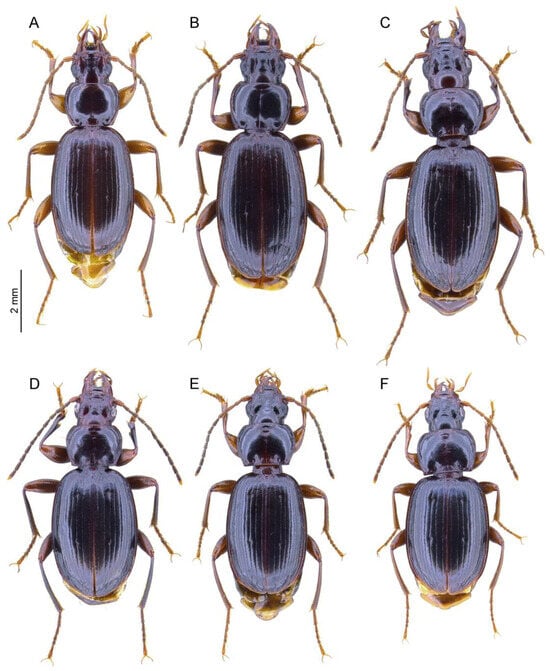
Figure 1
Open AccessArticle
Description of Bisbalus, a New Genus for the Gray Brocket, Mazama cita Osgood, 1912 (Mammalia, Cervidae), as a Step to Solve the Neotropical Deer Puzzle
by
Eluzai Dinai Pinto Sandoval, Wlodzimierz Jędrzejewski, Jesús Molinari, Miluse Vozdova, Halina Cernohorska, Svatava Kubickova, Agda Maria Bernegossi, Renato Caparroz and José Mauricio Barbanti Duarte
Taxonomy 2024, 4(1), 10-26; https://doi.org/10.3390/taxonomy4010002 - 02 Jan 2024
Abstract
►▼
Show Figures
The Neotropical deer genus Mazama is characterized by homoplastic morphological characters, a high karyotypic diversity, and a polyphyletic condition. The species of the genus have been recovered into two multigeneric lineages, the subtribes Odocoileina and Blastocerina, of the tribe Odocoileini (New World deer)
[...] Read more.
The Neotropical deer genus Mazama is characterized by homoplastic morphological characters, a high karyotypic diversity, and a polyphyletic condition. The species of the genus have been recovered into two multigeneric lineages, the subtribes Odocoileina and Blastocerina, of the tribe Odocoileini (New World deer) in the family Cervidae. Within the Blastocerina, gray brockets include two non-sister species, Subulo gouazoubira, occurring south of the Amazon region, and Passalites nemorivagus, occurring in the Guianas and in the Amazon region. We clarify the taxonomic status and phylogenetic position of Mazama americana citus Osgood, 1912 (referred to as either S. gouazoubira or P. nemorivagus by other authors). We collected a topotype of M. a. citus from the eastern shore of Lake Maracaibo, Venezuela, characterize it morphologically and cytogenetically (conventional banding and fluorescence in situ hybridization), and carry out a phylogenetic analysis of its whole mitogenome and Cytb alongside two additional specimens of M. a. citus from northwestern Venezuela. Our analyses reveal the topotype to be a large gray brocket with a cinnamon band above the eyes and 2n = 61 and FN = 70 karyotype. Using cattle whole chromosome painting and bacterial artificial chromosome X probes, we determined its karyotype to differ in at least 10 rearrangements from that of S. gouazoubira. Bayesian inference recovers M. a. citus within the Blastocerina subtribe, separated phylogenetically from other gray brockets (100% branch value), revealing the Osgood’s gray brocket to be a valid species that should be assigned to a new genus. We propose the generic name Bisbalus, with Bisbalus citus (Osgood, 1912) as the type species.
Full article
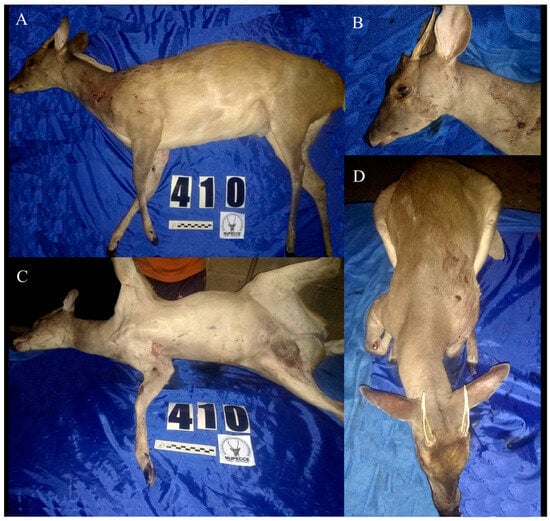
Figure 1
Open AccessArticle
A New Gonolobus Species (Apocynaceae, Asclepiadoideae) from Sinaloa, Mexico
by
Leonardo O. Alvarado-Cárdenas, Juan F. Pío-León, Gilberto Morillo and Carla Sofía Islas-Hernández
Taxonomy 2024, 4(1), 1-9; https://doi.org/10.3390/taxonomy4010001 - 02 Jan 2024
Abstract
►▼
Show Figures
In this study a new species of Gonolobus, G. villasenorii, is described. It is endemic to Sinaloa, Mexico, distributed in the Sierra Madre Occidental in pine–oak forest. This species is characterized by the presence of lanceolate sepals, margin of the corolla
[...] Read more.
In this study a new species of Gonolobus, G. villasenorii, is described. It is endemic to Sinaloa, Mexico, distributed in the Sierra Madre Occidental in pine–oak forest. This species is characterized by the presence of lanceolate sepals, margin of the corolla lobes with a whitish-green callus, without being cristate, and anthers with rectangular dorsal appendages. The new species is compared to Gonolobus chloranthus and Gonolobus erianthus. Gonolobus grandiflorus, Gonolobus incerianus, and Gonolobus lozadae are species with which it shares reticulate corollas and flowers more than 2 cm in diameter. A detailed description of the new species includes data on its habitat, ecology, phenology, conservation status, a distribution map, and a section where the new species is compared with similar species and how to recognize it.
Full article
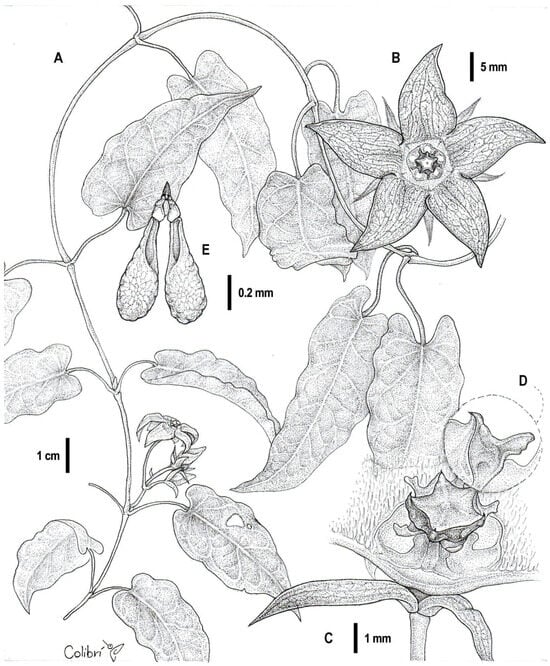
Figure 1
Open AccessCommunication
A New and Little-Known Species of the Ground Beetle Genus Nebria Subgenus Falcinebria Ledoux and Roux, 2005 (Coleoptera: Carabidae) from Japan
by
Kôji Sasakawa
Taxonomy 2023, 3(4), 551-558; https://doi.org/10.3390/taxonomy3040031 - 12 Dec 2023
Abstract
►▼
Show Figures
This paper presents additional notes on the carabid genus Nebria subgenus Falcinebria Ledoux and Roux, 2005 from Japan: a description of a new species Nebria suzukana sp. nov. from Mt. Gozaishodake; a new distribution and the southwesternmost collection record of Nebria furcata Sasakawa,
[...] Read more.
This paper presents additional notes on the carabid genus Nebria subgenus Falcinebria Ledoux and Roux, 2005 from Japan: a description of a new species Nebria suzukana sp. nov. from Mt. Gozaishodake; a new distribution and the southwesternmost collection record of Nebria furcata Sasakawa, 2020 from Mt. Uchimiyama; an additional record of Nebria kobushicola Sasakawa, 2023 from the Yatsugatake Mountains; and an additional record of an undetermined species from the Iide Mountains that was previously treated as Nebria taketoi Habu, 1962, with a note on its habitat. In addition, a key to the known species of Nebria (Falcinebria) from Honshu is provided.
Full article
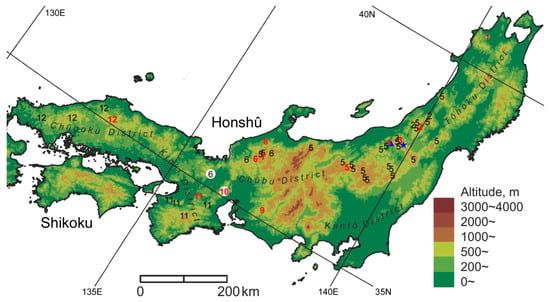
Figure 1
Open AccessArticle
The Relationship between the Rhizothrichidae Por (Copepoda: Harpacticoida) and the Cletodoidea Bowman & Abele, Including the Establishment of a New Genus and the Description of a New Species
by
Kai Horst George, Andreina Zey and Jana Packmor
Taxonomy 2023, 3(4), 528-550; https://doi.org/10.3390/taxonomy3040030 - 09 Dec 2023
Cited by 1
Abstract
►▼
Show Figures
During expedition EMB-238 of RV EM BORGESE to the Fehmarn Belt (Baltic Sea, Germany) in 2020, specimens of a new species of the Rhizothrichidae Por (Crustacea, Copepoda, Harpacticoida) were found. Currently, Rhizothrichidae enclose two genera: Rhizothrix Sars and Tryphoema Monard. The assignment of
[...] Read more.
During expedition EMB-238 of RV EM BORGESE to the Fehmarn Belt (Baltic Sea, Germany) in 2020, specimens of a new species of the Rhizothrichidae Por (Crustacea, Copepoda, Harpacticoida) were found. Currently, Rhizothrichidae enclose two genera: Rhizothrix Sars and Tryphoema Monard. The assignment of the new species is based on the following commonly derived characters: the formation of a strong spinulose (sub)apical element on the last segment of the female A1, and the formation of a long brush seta on the last exopodal and endopodal segments of the P1. The new species could not be assigned to either Rhizothrix or Tryphoema because it lacks their autapomorphies but presents exclusive derived characters, including the absence of the abexopodal seta on the A2 allobasis, the possession of only one seta on the endopods of P2–P4, and the fusion of the female P5 exopod and baseoendopod. Therefore, it is assigned to a new genus. Besides the species description, its phylogenetic position in the Rhizothrichidae as well as its possible relationship with Rhizothrix and Tryphoema are discussed. Furthermore, the affiliation of the Rhizothrichidae with the Cletodoidea is justified on the basis of 17 apomorphies. A key to the rhizothrichid genera is provided.
Full article
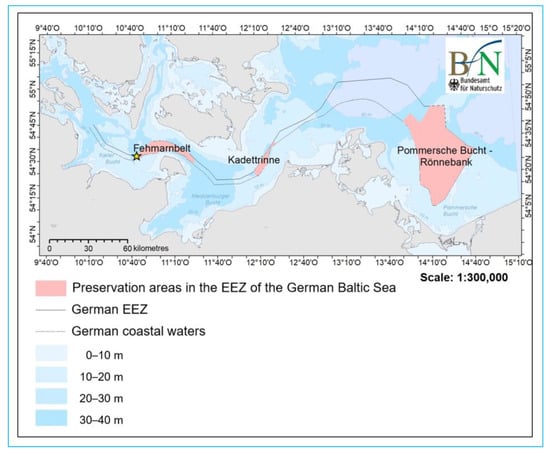
Figure 1
Open AccessArticle
On the Tarantula Genus Xenesthis Simon, 1891, with Description of a New Species from Venezuela (Araneae: Theraphosidae)
by
Danniella Sherwood, Ray Gabriel, Pedro Peñaherrera-R., Antonio D. Brescovit and Sylvia M. Lucas
Taxonomy 2023, 3(4), 509-527; https://doi.org/10.3390/taxonomy3040029 - 01 Dec 2023
Cited by 1
Abstract
►▼
Show Figures
The type material of Xenesthis colombiana Simon, 1891, X. immanis Ausserer, 1875, and X. monstrosa Pocock, 1903, are redescribed, with additional specimens of X. colombiana recorded. A neotype is designated for Xenesthis intermedia Schiapelli and Gerschman, 1945, as the holotype is lost; the
[...] Read more.
The type material of Xenesthis colombiana Simon, 1891, X. immanis Ausserer, 1875, and X. monstrosa Pocock, 1903, are redescribed, with additional specimens of X. colombiana recorded. A neotype is designated for Xenesthis intermedia Schiapelli and Gerschman, 1945, as the holotype is lost; the female is redescribed, and the male is described for the first time. A new species, Xenesthis avanzadora sp. nov., is described from Venezuela based on a holotype male.
Full article
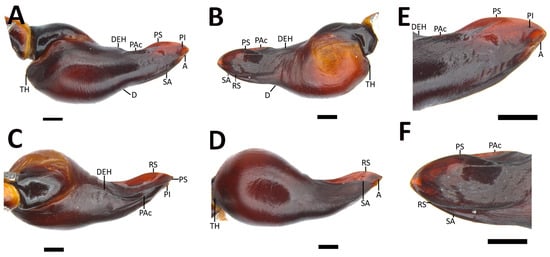
Figure 1
Open AccessArticle
Description of a Highly Modified Endemic Ground Beetle (Coleoptera, Carabidae) from the Oceanic Island of Malpelo, Colombia
by
Pierre Moret, Anderson Arenas-Clavijo and Mateo López-Victoria
Taxonomy 2023, 3(4), 496-508; https://doi.org/10.3390/taxonomy3040028 - 22 Nov 2023
Abstract
The oceanic island of Malpelo, 380 km west of the Colombian mainland, stands out from other islands of the Tropical Eastern Pacific by its harsh environment and depauperate flora and fauna, thus imposing strong selective pressure on the small number of invertebrates that
[...] Read more.
The oceanic island of Malpelo, 380 km west of the Colombian mainland, stands out from other islands of the Tropical Eastern Pacific by its harsh environment and depauperate flora and fauna, thus imposing strong selective pressure on the small number of invertebrates that inhabit it. The endemic taxon described here, Dyscolus (Cacothrix) malpelensis, n. subgen., n. sp. (Carabidae, Platynini), is a remarkable example of adaptation to this unique ecosystem. The modifications of its body shape, including a tight coaptation of elytra and pronotum, might be a response to strong environmental constraints, from predation by lizards and land crabs to the absence of deep soil that forces the beetle to seek shelter in caves and rock crevices.
Full article
(This article belongs to the Special Issue Diversity, Distribution and Zoogeography of Coleoptera)
►▼
Show Figures
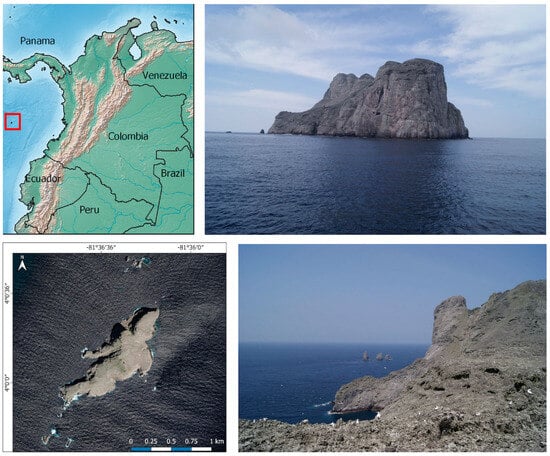
Figure 1
Open AccessArticle
Pseudoscorpions of Israel: Annotated Checklist and Key, with New Records of Two Families (Arachnida: Pseudoscorpiones)
by
Sharon Warburg, Shlomi Aharon, Igor Armiach Steinpress, Prashant P. Sharma, Danilo Harms and Efrat Gavish-Regev
Taxonomy 2023, 3(4), 466-495; https://doi.org/10.3390/taxonomy3040027 - 24 Oct 2023
Abstract
►▼
Show Figures
The location of Israel at the junction of three continents leads to a unique fauna of both Palearctic and Afrotropical zoogeographic origins. Following systematic revisions over the past sixty years and the discovery of new species, the only available key to the pseudoscorpions
[...] Read more.
The location of Israel at the junction of three continents leads to a unique fauna of both Palearctic and Afrotropical zoogeographic origins. Following systematic revisions over the past sixty years and the discovery of new species, the only available key to the pseudoscorpions of Israel has become outdated. We provide here an up-to-date checklist of the pseudoscorpion species of Israel including distribution maps, and the first illustrated identification key of the Israeli fauna based on morphological characters. Prior to our study, this fauna comprised twelve families, 26 genera and 52 morphospecies, including several “subspecies”. We increase this number and list 61 pseudoscorpion morphospecies that belong to 28 genera and fourteen families. Most species are Palearctic and Mediterranean, and only a few are Afrotropical. Two families new to Israel are reported here for the first time: Syarinidae and Cheiridiidae. Both families are cosmopolitan and have representatives in the Mediterranean region. The putative new species are presented here at a genus level and will be described separately elsewhere.
Full article
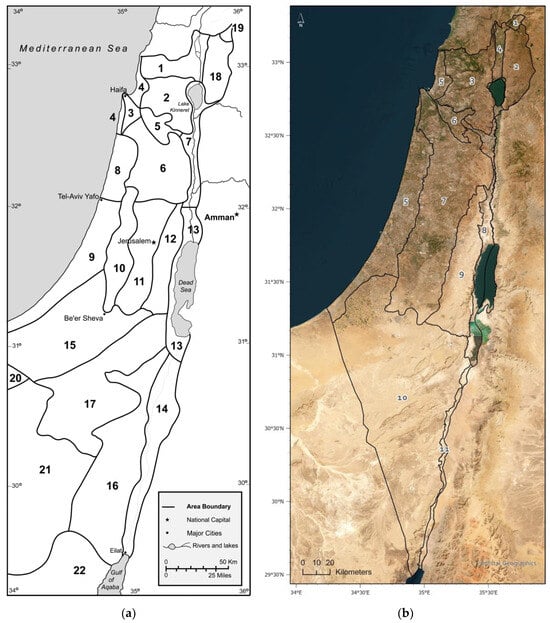
Figure 1
Open AccessArticle
Redefining the Taxonomic Boundaries of Genus Xanthomonas
by
Kanika Bansal, Sanjeet Kumar, Anu Singh, Arushi Chaudhary and Prabhu B. Patil
Taxonomy 2023, 3(4), 452-465; https://doi.org/10.3390/taxonomy3040026 - 09 Oct 2023
Cited by 1
Abstract
►▼
Show Figures
The genus Xanthomonas primarily comprises phytopathogenic species. By carrying out deep phylo-taxonogenomics, we recently reported that the genera Xylella, Stenotrophomonas, and Pseudoxanthomonas are misclassified and belong to the genus Xanthomonas. Considering the importance of Xanthomonas/Xylella as plant pathogens
[...] Read more.
The genus Xanthomonas primarily comprises phytopathogenic species. By carrying out deep phylo-taxonogenomics, we recently reported that the genera Xylella, Stenotrophomonas, and Pseudoxanthomonas are misclassified and belong to the genus Xanthomonas. Considering the importance of Xanthomonas/Xylella as plant pathogens and to further determine the taxonomic and phylogenetic breadth of this genus, we extended our earlier study by including all the reported genera and families in the order. This investigation revealed that at least four more genera belong to the genus Xanthomonas, with a notable case being Lysobacter, after which the family and order are named. Similarly, our investigation also allowed us to reveal the expanded taxonomic breadth of the related genus Rhodanobacter. This finding of a major related genus that lacks plant pathogenic species will allow for taxonomy-based comparative studies. The phylo-taxonogenomic revelations were further supported by complete 16S rRNA-based sequence boundaries proposed for genus delineation. Accordingly, we propose a taxonomic revision of these major and closely related genera along with their constituent families within the order Lysobacteraceae (Xanthomonadaceae). The identification of a major related genus lacking plant pathogenic species will be important in investigating the origin and success of pathogenic species/lineages in the genus Xanthomonas.
Full article
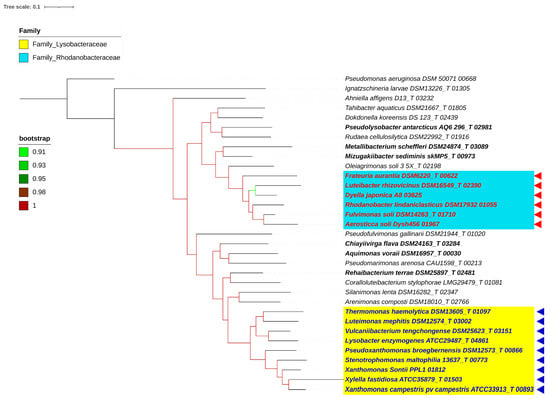
Figure 1
Highly Accessed Articles
Latest Books
E-Mail Alert
News
Topics

Conferences
Special Issues
Special Issue in
Taxonomy
Taxonomy, Systematics and Biogeography of Spiders
Guest Editors: Antônio Domingos Brescovit, Adalberto J. SantosDeadline: 30 June 2024
Special Issue in
Taxonomy
Diversity, Distribution and Zoogeography of Coleoptera
Guest Editors: Massimo Meregalli, Pier Mauro GiachinoDeadline: 30 November 2024



